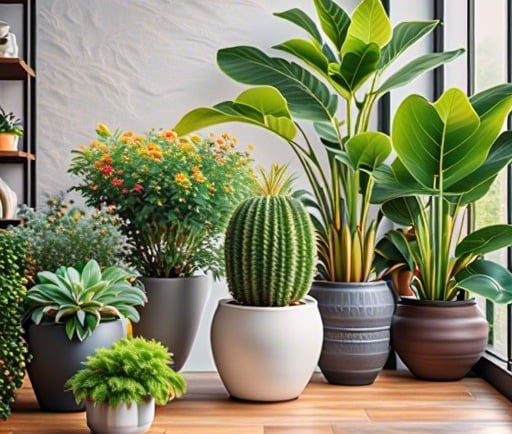The Importance of Air Purifying Plants for Improving Indoor Air Quality
PLANT


Air purifying plants have become increasingly popular in recent years as more people become aware of the negative effects of indoor air pollution. Many common household items, such as cleaning products, furniture, and even carpets, can release volatile organic compounds (VOCs) into the air. These VOCs can cause a range of health issues, including respiratory problems, allergies, and even cancer.
Having air purifying plants in your home can help to combat these issues. Plants have the natural ability to absorb carbon dioxide and release oxygen through a process called photosynthesis. In addition to this, certain plants have been found to have the ability to filter out harmful toxins from the air.
One of the most well-known air purifying plants is the spider plant (Chlorophytum comosum). This plant is not only easy to care for but also has the ability to remove formaldehyde, xylene, and toluene from the air. These chemicals are commonly found in household products such as paint, adhesives, and cleaning agents.
Another popular air purifying plant is the peace lily (Spathiphyllum). This plant is not only aesthetically pleasing with its beautiful white flowers but also has the ability to remove common indoor air pollutants such as benzene, trichloroethylene, and ammonia. Benzene is commonly found in plastics, synthetic fibers, and tobacco smoke, while trichloroethylene is found in adhesives, solvents, and paint removers.
In addition to these specific plants, having a variety of different types of plants in your home can help to improve air quality. Different plants have different abilities to filter out specific pollutants, so having a diverse range of plants can provide a more comprehensive purification system.
It's important to note that while air purifying plants can help to improve air quality, they should not be relied upon as the sole means of purification. It's still important to have proper ventilation in your home and to avoid using products that release harmful chemicals into the air.
In conclusion, air purifying plants are a valuable addition to any home. Not only do they add beauty and greenery to your living space, but they also have the ability to filter out harmful toxins and improve the air quality. Consider incorporating air purifying plants into your home to create a healthier and more pleasant living environment.
Understanding Indoor Air Pollution
Before we dive into the top air-purifying plants for your home, let's take a closer look at indoor air pollution. Common sources of indoor air pollution include volatile organic compounds (VOCs) emitted from household products, such as cleaning supplies, paints, and furniture. These VOCs can release harmful chemicals into the air, contributing to poor indoor air quality.
In addition to VOCs, other pollutants can come from outdoor sources, such as pollen, dust, and vehicle emissions. These particles can easily enter our homes through open windows, doors, or even on our clothes and shoes. Once inside, they can accumulate and circulate in the air, posing a risk to our health.
Prolonged exposure to indoor air pollution can lead to various health issues, including respiratory problems, allergies, and even asthma. The symptoms can range from mild discomfort, such as coughing and sneezing, to more severe conditions that require medical intervention. Children, the elderly, and individuals with pre-existing respiratory conditions are particularly vulnerable to the effects of poor indoor air quality.
This is why it's crucial to take steps to improve the air quality in your home, and one effective way to do so is by incorporating air-purifying plants into your indoor space. These plants have the ability to filter out harmful toxins and pollutants from the air, helping to create a healthier living environment.
When plants perform photosynthesis, they absorb carbon dioxide and release oxygen. This natural process not only helps to increase the oxygen levels in your home but also helps to remove other harmful gases, such as formaldehyde and benzene, which are commonly found in household products.
Furthermore, plants can also help to increase humidity levels in your home, which can be beneficial, especially during dry winter months when indoor air tends to be drier. Dry air can cause respiratory irritation and other discomforts, but plants release moisture through a process called transpiration, which can help to alleviate these issues.
However, it's important to note that not all plants are equally effective at purifying the air. Some plants are better at removing specific toxins than others, so it's essential to choose the right plants for your specific needs. In the following sections, we will explore some of the top air-purifying plants that you can consider adding to your indoor space.
The Top Air-Purifying Plants for Your Home
Now that we understand the importance of air-purifying plants, let's explore some of the top plants that can help improve the air quality in your home:
1. Snake Plant (Sansevieria trifasciata)
The Snake Plant, also known as Mother-in-Law's Tongue, is an excellent choice for air purification. It is known for its ability to remove toxins such as formaldehyde, benzene, xylene, and trichloroethylene from the air. This low-maintenance plant thrives in low light conditions, making it perfect for any room in your home.
2. Peace Lily (Spathiphyllum)
The Peace Lily is not only a beautiful plant but also a powerful air purifier. It can effectively remove common indoor pollutants, including formaldehyde, benzene, and trichloroethylene. Additionally, the Peace Lily can increase humidity levels in your home, which can be beneficial, especially during dry winter months.
3. Spider Plant (Chlorophytum comosum)
The Spider Plant is a popular choice for indoor gardening enthusiasts. It is known for its ability to remove formaldehyde and xylene from the air. This plant is easy to care for and can thrive in a variety of lighting conditions, making it a versatile option for any room in your home.
4. Aloe Vera (Aloe barbadensis)
Aloe Vera is not only known for its healing properties but also for its air-purifying abilities. It can effectively remove formaldehyde from the air, which is commonly found in cleaning products and furniture. Aloe Vera plants are easy to care for and can add a touch of green to your home while improving the air quality.
5. Boston Fern (Nephrolepis exaltata)
The Boston Fern is a popular choice for indoor hanging baskets. It is known for its ability to remove formaldehyde, xylene, and toluene from the air. This plant thrives in high humidity and indirect light, making it a perfect choice for bathrooms or kitchens.
These are just a few examples of air-purifying plants that you can incorporate into your home to improve the air quality. However, it is important to note that the effectiveness of these plants in purifying the air may vary depending on factors such as the size of the room and the level of pollution. Therefore, it is recommended to have multiple plants in different areas of your home to maximize the benefits.
In addition to their air-purifying properties, these plants also offer numerous other benefits. They can help reduce stress, increase productivity, and improve overall well-being. Furthermore, having plants in your home can enhance the aesthetic appeal and create a calming and relaxing atmosphere.
When choosing air-purifying plants for your home, consider factors such as the amount of sunlight available, the level of maintenance required, and your personal preferences. It is also important to ensure that you provide the necessary care, such as watering and fertilizing, to keep the plants healthy and thriving.
By incorporating air-purifying plants into your home, you can create a healthier and more enjoyable living environment for you and your family. So why not bring some greenery indoors and reap the benefits that these plants have to offer?
6. Consider the Size of Your Space
When incorporating air-purifying plants into your home, it's important to consider the size of your space. Larger plants may overpower a small room, while smaller plants may get lost in a large space. Choose plants that are proportionate to the size of the room to create a balanced and harmonious environment.
7. Rotate Plants for Balanced Growth
To ensure that your air-purifying plants grow evenly and thrive, consider rotating them every few weeks. This will allow all sides of the plant to receive adequate sunlight and prevent one side from becoming overexposed or leggy. Additionally, rotating the plants will promote balanced growth and prevent them from leaning towards the light source.
8. Use Decorative Planters
Enhance the aesthetic appeal of your indoor garden by choosing decorative planters for your air-purifying plants. Opt for pots that complement your home's decor and style. Consider using a variety of materials such as ceramic, terracotta, or woven baskets to add visual interest and texture to your space.
9. Incorporate Plants in Every Room
To maximize the air-purifying benefits, try to incorporate plants in every room of your home. Not only will this improve the air quality throughout your entire living space, but it will also create a cohesive and natural ambiance. Consider placing plants on windowsills, countertops, shelves, or hanging them from the ceiling to add greenery and life to every corner of your home.
10. Monitor and Adjust Care as Needed
Lastly, it's important to monitor the health of your air-purifying plants and adjust your care routine as needed. Pay attention to any signs of distress such as yellowing leaves, wilting, or pests. Adjust watering, lighting, and humidity levels accordingly to ensure that your plants thrive and continue to purify the air in your home.
By following these tips, you can successfully incorporate air-purifying plants into your home and create a healthier and more vibrant living environment.
